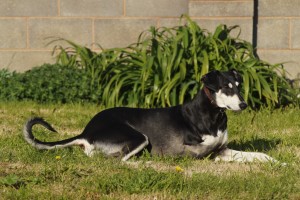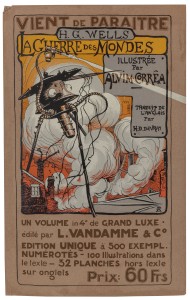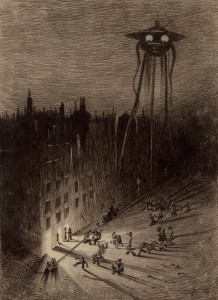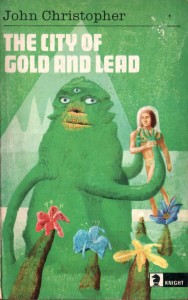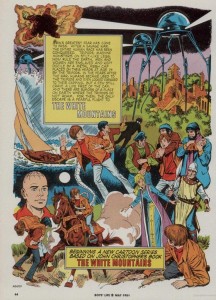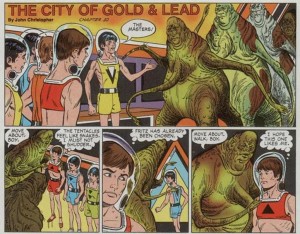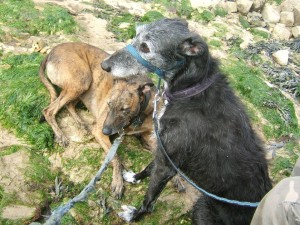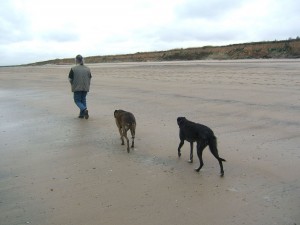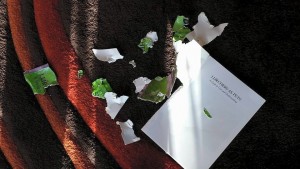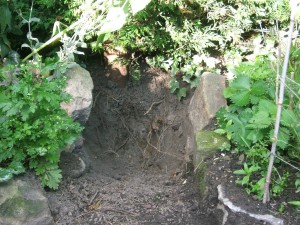For your mid-week pictorial pleasure, dear listeners, we have a beautiful three-legged longdog, John Christopher‘s The Tripods trilogy, H G Wells and an Edwardian artist from Brazil. All good things come in threes, except possibly ravening metal war-machines from Mars. They can be annoying.
Last week we were talking about rescue centres and Lurcher SOS, which reminded me of my plan for a gallery to show off these magnificent beasts. I was pottering on the Lurcher Link forum a while ago, and a member there, Michaela, kindly sent us some marvellous pictures of her three-legged Nicky, a saluki x greyhound and thus a true longdog. Proof that you don’t need four legs to be a wild rover. Here’s just a few shots of Nicky…
Three-legged lurchers and longdogs surprise some people with their ability to match any four-legs, and you’d be amazed at their speed and agility. Thanks again for those, Michaela.
####
Tripods don’t end there. It seemed wasteful to show off Nicky and not to use the opportunity to go weird. We needed two other, far stranger (and less licky) examples of tripods to complete the article. As we’re generally being arty at the moment, our second focus is on the artist Henrique Alvim Correa.
 Correa was born in Brazil in 1876, but his family moved to France when he was a teenager, and he eventually settled in Belgium. His relevance to greydogtales, apart from being a neat artist, is that he illustrated the 1906 Belgian edition of H G Wells‘ War of the Worlds. Despite the various re-imaginings of Wells’ tripods, and the filmed versions, Correa’s pictures should be the iconic ones, capturing the feel of the age so well just nine years after the book’s publication.
Correa was born in Brazil in 1876, but his family moved to France when he was a teenager, and he eventually settled in Belgium. His relevance to greydogtales, apart from being a neat artist, is that he illustrated the 1906 Belgian edition of H G Wells‘ War of the Worlds. Despite the various re-imaginings of Wells’ tripods, and the filmed versions, Correa’s pictures should be the iconic ones, capturing the feel of the age so well just nine years after the book’s publication.
(On a personal note, I found some of the acting in the 2005 Spielberg film too annoying to enjoy the images and special effects fully. I had to re-watch the 1953 version with Gene Barry to cheer myself up again.)
Apparently Correa himself initiated the idea after reading War of the Worlds, and came to the UK with his drawings to show to H G Wells. Wells loved them and Correa was asked to illustrate the special illustrated edition being planned by Vandamme, the Belgian publishers, which he did. Sadly Correa had tuberculosis and died only four years later, in 1910.
Here are a few of the brilliant Correa illustrations to enjoy:
As soon as I’d written the above, as usually happens, I discovered the monsterbrains site which has loads more Correa art on display. Aeron Alfrey of monsterbrains also creates his own unique imagery inspired by the macabre, grotesque and monstrous. It’s well worth a visit to browse the other weird art there:
I was going to resist, but it proved impossible not to mention Jeff Wayne‘s War of the Worlds musical/narrative version after looking at the Correa drawing of the Thunderchild. That song always sends shivers up my spine (and I prefer this to Spielberg’s, as well. Sorry, Steve).
The third piece today had to be a mention of the late John Christopher and The Tripods. And it’s a trilogy. Three time three times three. That’s practically nine, the number of worlds in Norse mythology, and a lucky number in Chinese associated with the dragon. Where am I? This isn’t my arm…
John Christopher. Or Samuel Youd, actually, and he only died three years ago. Author of The Death of Grass (1956) and The World in Winter (1962), two excellent early post-apocalyptic novels from when the Brits did that kind of thing rather well. We’re not here for the writing today, though, but a brief mention of the artistic interpretations.
I loved The Tripods when I was young. The White Mountains, The City of Gold and Lead, and The Pool of Fire. My editions are, predictably, the 1967 Knight publications from the UK, not any of these modern fancy ones. Not quite sure what the artist was on.
The most notable graphic adaptation of The Tripods is in Boys’ Life magazine, which serialized all three books in the eighties. The artist was Frank Bolle, an American who drew decades worth of comic strips for young people, did book covers and a whole lot more.
And thanks to the wonders of the Internet, you can find a large graphic resource of Bolle’s Tripods work by following the link below to The Haunted Closet blog:
In 1985, just before the Bolle version of the three novels for Boy’s Life finished, the BBC produced comic strip versions of their own. These were not direct adaptations, though, and had the protagonists veering off on other adventures which were not in the original books. The artists this time was John Burns, but there was no resolution because in the end the BBC dropped the Junior Television Magazine in which they were appearing.
Hmm, doughboy Masters? Anyway, for many older listeners, their thought will be of the televised Tripods from the BBC and the Australian Seven Network. They only managed to adapt the first two books, in 1984 and 1985, but it was a good try – and they did have proper tripods, the Masters, rather than men in rubber suits.
If you check out this video link, you can skip to about minute 6 to see the tripods themselves.
And there you have it – three tripods. Lots more could be said, but we’re out of time again.
More longdogs and lurchers, weird art and artist interviews coming up, and we’ll be joined by a couple of great authors in December. Plus the nice people at the M R James Appreciation Group have suggested some excellent ideas for neglected supernatural/strange authors to cover over the next couple of months – E Nesbit, A N L Munby, Fitz-James O’Brien, H Russell Wakefield… oh dear. Work to do, then.
